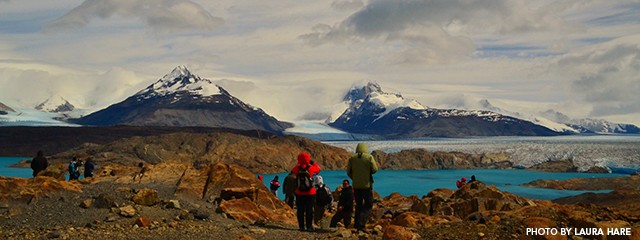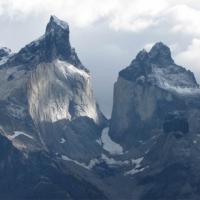The Holbrook Explorer

How to Pack for Patagonia
How to Pack for Patagonia
Patagonia is known the world over for its breathtaking, remote, and sometimes challenging terrain, offering travelers rewarding opportunities for hiking, boating, and other activities. Since packing for Patagonia can be confusing, we’ve compiled the recommendations below to help you prepare.
Weather
Because Argentina and Chile are south of the equator, seasons are reversed from those of the Northern Hemisphere. Patagonia is cool and windy all year, with snow in winter. The winds are typically strongest from November to February, though still formidable in the shoulder months. Weather in the southern regions can be unpredictable and may change drastically in a very short time. For this reason, dressing in layers is key. Clothing should be comfortable and allow for freedom of movement (such as sportswear). A sturdy pair of walking shoes or hiking boots is strongly recommended; make sure shoes are broken in prior to travel.

Tips for building layers:
Building a system of layers begins with the layer next to the skin, the base layer. Synthetic fabrics work best by reducing moisture and wicking perspiration away from the skin. Nylon hiking pants or zip-off hiking pants are ideal, and for added warmth you may want to add thermal underwear (preferably polypropylene rather than cotton). The next important layer is a fleece, down, or synthetic-filled jacket as an insulating layer, followed by a rain- and windproof layer.
Other considerations:
If you will be hiking, pay special attention to footwear. A sturdy pair of broken-in hiking boots, liner socks, and heavy woolen socks are recommended.
The sun can be strong in Patagonia: Pack a brimmed hat, sunscreen, and sunglasses to protect against the strong UV rays.
Lastly, if you are flying into either country’s capital, keep in mind that Buenos Aires has a climate similar to New York City, although its winters are considerably milder and without snow. Santiago has a cool, semi-arid climate. Locals in both cities are known for their fashionable styles and impeccable attire.

Suggested packing list:
Each traveler has unique needs and preferences, but here’s our recommended packing list to get you started.
Clothing:
- Jackets: Pack clothing that can be worn in layers and include a polar fiber or down jacket as well as a pair of gloves. A sweater, vest, and down jacket may be needed for cool nights or at higher elevations.
- Shirts: Pack several short- and long-sleeved T-shirts to layer under a sweatshirt and jacket as needed.
- Shorts: Patagonia has cool weather year-round, but you may wish to pack a pair of shorts in case of a warm spell during the summer months (December– March).
- Pants: Plan to bring long, loose-fitting pants suitable for hiking. Zip-off pants are useful since days tend to become warmer towards late morning and cooler in the afternoon.
- Underclothing, socks, and sleepwear: Bring some thin, synthetic socks (liner socks), heavy woolen socks, and a few pairs of thermal underwear (polypropylene or silk). Underwear, socks, and nightwear should be lightweight and designed to dry quickly. Warm hiking socks (e.g. Smartwool or similar) are strongly recommended for active travelers. You may wish to pack a fleece top and pants to sleep in.
- Headgear: Include a hat (preferably with a wide brim) for sun protection. A tie under the chin is helpful in case of windy conditions. Beanie hats are excellent for windy conditions.
- Sunglasses with a neck cord or other holder are useful.
- Bathing suit: Pools are available at some hotels.
- Shoes: Bring a pair of broken-in leather/waterproof material trekking boots with good ankle support, and perhaps a pair of walking shoes for cities/non-field wear. Shoes should be comfortable enough to wear all day. To save space in your luggage, wear your hiking boots while flying or pack in your carry-on. You may also want to pack a pair of sport strap-sandals (e.g. Teva or Keen).
- Rain gear: Consider a pair of rain pants and jacket with full side zips (Gore-Tex shell or similar for both) or a long, hooded rain poncho to cover you and your gear.

Toiletries:
- Personal toiletries: Put personal toiletries in a zip-top bag. Take small containers that hold only what you will need during the trip.
- A face cloth or small towel of lightweight, well-worn cotton that dries quickly
- An electric razor or hair dryer (remember a converter for foreign countries, and/or an adapter for outlet plugs)
- Personal medication and copies of prescriptions: We advise you to carry these with you as you travel in case of lost luggage.
- Dramamine if you are prone to motion sickness
- Some travelers have suggested Probiotic supplements as a preventative measure to regulate your system while traveling to new areas.
- Sunscreen and lip balm with SPF (important at higher altitudes!)
- Insect repellant
- Small quantity of laundry detergent if you’ll be washing clothing by hand
- Individual, pre-moistened towelettes and/or hand sanitizer
- Contact lenses and/or an old pair of eyeglasses (in case of breakage) with a copy of your eyeglass prescription
- Small packets of tissues (useful for everything from toilet paper to napkins)
In addition to your toiletries, it is useful to pack a small first aid kit, which you can easily prepare. Helpful items include bandages, mosquito repellent wipes, antihistamine, a pain-reliever, individually-wrapped moist wipes, anti-diarrhea medicine, anti-fungal cream, and an extra pair of disposable contact lenses or eyeglasses if you wear them.

Miscellaneous:
- Camera with extra batteries and memory cards, plus a waterproof dry bag
- Water bottle and accessories: Pack a reusable water bottle or thermos for hikes
- Athletic tape for blisters (1 ½ inch wide tape)
- A Swiss Army style pocket knife or multi-tool
- Day pack: Bring a light backpack to carry your water bottle/canteen, flashlight, camera (with extra memory card and battery), insect repellent, sunscreen, band aids, medications, toiletries, and other necessities during hikes.
- Collapsible walking stick or trekking poles: When considering bringing your own poles, please note that poles without rubber tips are usually not allowed at archaeological sites and ecologically sensitive areas.
- Small flashlight or headlamp
- Book light: LED book lights are compact and help to provide additional lighting for reading and/or writing
- Notepad and pens
- A mini-sewing kit and a few safety pins
- Travel alarm clock
- Important documents and photocopies of all documentation, passport, and tickets (e.g. passport, driver’s license, airline tickets, travel itinerary, maps, emergency phone numbers, insurance cards)
Did we miss anything? If you’ve visited Patagonia, feel free to add your suggestions in the comments!


